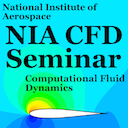80th NIA CFD Seminar
Topic: Understanding the Role of Thermal Nonequilibrium in Scramjet Flows
Date: Tuesday, December 13, 2016
Time: 11:00am-noon (EST)
Room: NIA, Rm137
Speaker: Venkat Raman
Speaker Bio: Venkat Raman received his PhD from Iowa State University in 2003 in the department of chemical engineering. He was a NASA/Center for Turbulence Research Postdoctoral Fellow at Stanford University from 2003-2004, and a research associate in the Center for Integrated Turbulence Simulations from 2004-2005. From 2005-2014, he was on the faculty of Aerospace Engineering and Engineering Mechanics Department at The University of Texas at Austin, initially as an assistant professor (2005-2011) and later as tenured associate professor (2011-2014). Raman received an NSF CAREER award, a distinguished paper award at the International Combustion Symposium, and the Moncrief Grand Challenge Award in 2013. He held the Eli. H and Ramona Thornton Centennial Fellowship in Engineering at UT Austin. Raman focuses on the development of computational models for turbulent reacting flows with application to aircraft and scramjet engines, stationary power generation, and synthesis of novel materials. His research group uses high performance supercomputers and detailed numerical simulations to study the performance of combustion devices. His recent focus has been in the areas of numerical error analysis, uncertainty quantification, and failure predictions, aimed towards modeling catastrophic and rare events in complex devices and natural systems.
Abstract: In most application of continuum fluid mechanics, the molecular motion is assumed to be at or near equilibrium, allowing the definition of a temperature of the fluid. In high-speed flows, the presence of shocks always causes nonequilibrium. More importantly, the short flow time scales imply that equilibrium may not be reached in the domain of interest. Such nonequilibrium has been widely studied in the context of hypersonic flows with application in re-entry dynamics. Here, we study such nonequilibrium in internal flows of relevance of scramjets. Thermal nonequilibrium most directly affects chemical reactions. Since flame stabilization is a critical factor in the successful operation of a scramjet engine, the role of a specific form of nonequilibrium, that of vibrational motions, is studied in detail here. Novel ab-initio derived rates are used to describe the ignition process. In particular, techniques to determine rates at relatively low enthalpy conditions (as compared to external flows) were developed. Direct numerical simulations of scramjet-type flows (performed on the NASA HECC machines) show that nonequilibrium affects ignition counter-intuitively, and is highly geometry dependent.
Additional information, including the webcast link, can be found at the NIA CFD Seminar website:
